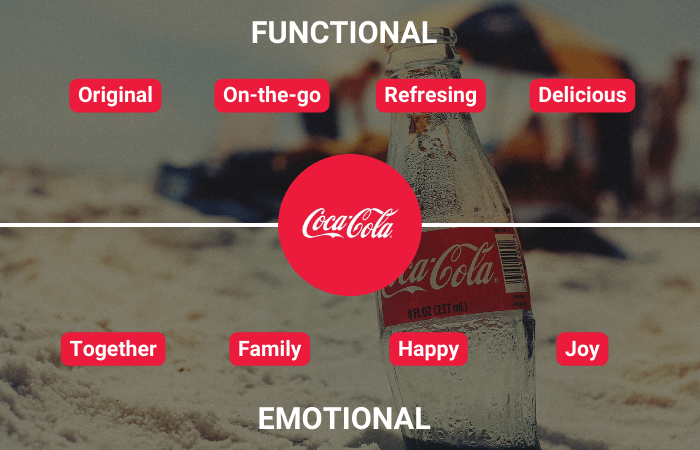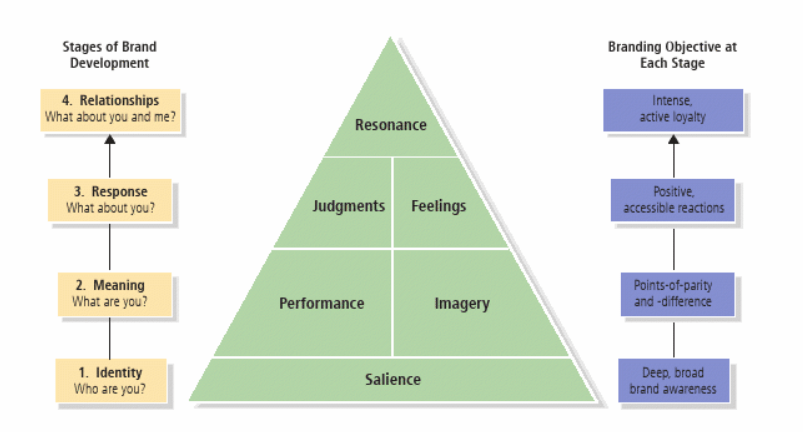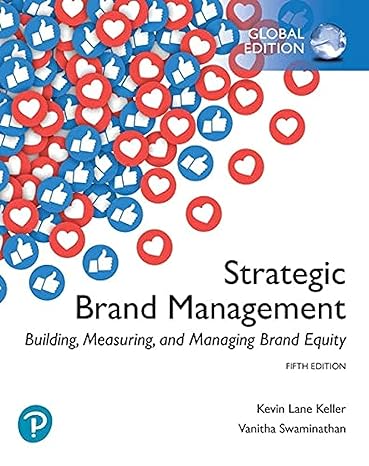What is Brand Equity?
Brand equity is the added value the brand name gives to a product or service. Brand equity is a multi-faceted concept, which has been critically discussed in many academic studies and professional sources. Now, let’s look at 4 different perspectives of what brand equity means that were first mentioned by Lalaounis in his book about Strategic Brand Management and Development.
‘Brand equity is the added value a given brand adds to a product or service. The value can be an extra amount of money people are willing to pay compared to other alternatives, or a favorable response to the brand message.’
Firm-based brand equity
This perspective sees brand equity as a measurable financial benefit that the brand has for the company. Firm-based brand equity constitutes the additional profits generated by the brand compared to an unbranded product. In other words, this represents the price advantage that a brand has over its competitors.
For example, strong brand equity allows Apple to charge its customers a premium price compared to other smartphone sellers like Samsung, Huawei, etc.
Customer-based brand equity
During this blog, I will focus on this perspective of brand equity, which is defined by how customers perceive a brand and how these perceptions influence their behaviours, trust, perceived quality, and loyalty. Besides, this perspective acknowledges that different people might have different views on our brands, meaning the value they see is unique to them.
Nike has exemplified this view very well. To most of us, Nike doesn’t just sell shoes, they sell a feeling of empowerment, athleticism, and determination. These associations go beyond the financial benefits of brand equity as Nike has brought about positive emotions and high loyalty no matter what prices it charges the consumers.
Economic-based brand equity
This theory examines the added value your brand provides beyond the mere functionality of the product itself.
Let’s take Tesla to review this. Tesla cars not only offer electric mobility but also represent a sustainable solution to our current environmental issues and cutting-edge technology. This perceived value justifies their higher price compared to traditional gasoline cars, even though the core function (transportation) remains the same.
Employee-based brand equity
The final view considers the impact of brand equity on internal employees. In short, having positive brand equity helps the firm foster pride, motivation, and engagement among employees, who feel stimulated by representing the company and its culture.
As a result, this translates into better customer service, innovation, creativity, and the company’s long-term success.
Fundamentals of building customer-based brand equity
In this blog, we pay more attention to this concept of customer-based brand equity as it has become the backbone of many firms’ branding success. According to Aaker (1998), customer-based brand equity is the differential effect that brand knowledge has on customer response to marketing activities. This means that when consumers recognize your brand, they’re more likely to respond positively to your marketing and products compared to unbranded competitors such as privately-owned items.
Understand customers’ brand knowledge
Brand knowledge is a set of associations in a customer’s memory that are specifically linked to a brand name. Let’s delve into 4 primary components of brand knowledge that are key to brand equity: awareness, association, image, and loyalty.
1. Brand Awareness
Brand awareness refers to how familiar consumers are with the brand. There are 2 key components that you have to manage: recall and recognition.
Recognition refers to consumers’ ability to identify a brand when exposed to its cues including visual elements such as logos, packaging, slogans, or auditory elements like taglines. Hence, effective brand recognition requires consistent brand identity elements that are repeatedly presented across communication channels. A study shows that people are 2 times more likely to choose the brand that they recognize and around 60% prefer to buy brands with good reputation and awareness.
Recall denotes a deeper level of our memory processing. Specifically, it reflects our ability to retrieve a brand without any prompts and cues. This typically occurs when a consumer faces a purchase decision or encounters a relevant need or category.
2. Brand Association
Brand association includes ideas, feelings, and any mental attributes linked to the brand in consumers’ mind. These can be functional or emotional depending on the focused values of the category.
For example, Coca-Cola has done a great job in building and managing important brand associations both functionally and emotionally, which help it shape consumers’ perceptions and behaviours and bolster its brand equity. Coca-Cola is known for its consistent and original taste, being available almost everywhere and offering us the refreshment on-the-go. Meanwhile, its marketing associates it with joy, happiness, and togetherness, cultivating desired associations related to family and nostalgia in consumers’ memory.

3. Brand image
The overall perception of the brand, shaped by both brand awareness and brand associations, is brand image. In other words, brand image is the reputation a brand builds in the world and the overall impression people have of it.
The initial block of brand image is awareness as the audience needs to know the brand exists before they can form any further associations. This can be shaped by messages conveyed via marketing communications channels or by customer experiences including purchase and post-sales services.
4. Brand Loyalty
Brand loyalty represents a customer’s consistent preference and commitment to a brand over its competitors. Generally, this preference goes beyond simply choosing the brand once; it involves repeated purchases, positive word-of-mouth recommendations, and a willingness to pay a premium.
Brand loyalty plays a significant role in building strong brand equity as retaining existing customers is indeed more cost-effective and profitable than acquiring new ones. It is estimated that acquiring a new consumer is 5 times as expensive as retaining one. Hence, strong brand equity signals a high level of loyalty which can generate consistent revenue for the business, build a reputation with positive testimonials, and make consumers less sensitive to prices or competitors’ marketing activities.
Build Brand Equity by Understanding Customer Response to Marketing Activities
To measure brand equity, it is recommended that the company should figure out how consumers react to its Marketing activities as it reveals the direct impact the brand has on the target audience. Having positive brand equity can result in a higher level of brand awareness and differentiation, and positive attitudes towards brand messages and communications, leading to higher advocacy and loyalty. The following is going to tell how strengthing brand equity can be beneficial to the firm:
• Amplified brand awareness: consumers can easily remember your brand when prompted with a product category (Smartphone = Apple, Soft drink = Coca-Cola). Not to mention, awareness is even amplified by loyal consumers who are willing to spread organic promotions to their social networks.
• High engagement with brand communications: according to a recent study, 70% of people, who are emotionally engaged with the brand, spend twice as much as those who are not. This also means that consumers have higher curiosity and pay more attention to the brand’s marketing messages, whether social media posts, adverts, or in-store displays.
• Price Tolerance: companies with strong brand equity enjoy a price advantage over competitors as their consumers do not often consider prices when making buying decisions. A survey by the Wise Marketer in 2019 found that 80% of customers are willing to pay a premium price to enjoy the experience from their favourite brands.
• Brand Advocacy: as consumers react more favourably to the brand message, they actively promote it online through reviews, referrals, etc. These brand advocates are a primary source of spreading beautiful words to their friends, family, and online communities.
How to Measure Customer Response to Marketing?
As understanding how consumers respond to the brand’s marketing is necessary to sustain strong customer-based brand equity, many marketers have to come up with a variety of tactics to help them measure this component:
• Surveys: Conduct online or offline surveys to directly ask customers about their brand awareness, associations, and behaviour.
• Market research: Utilize qualitative and quantitative research to understand customer perceptions and sentiment.
• Social media monitoring: Track online conversations and brand mentions to gauge customer feelings and brand engagement.
• Website analytics: Analyze website traffic, clicks, and conversions to understand how customers interact with your brand online.
• Loyalty programs: Implement loyalty programs to track purchase behaviour and reward loyal customers, gaining valuable insights into their preferences.
Read more on brand management: Brand Management: How To Build Profitable Brand Equity in 2024
The Benefits of Building Strong Brand Equity
1. Better perceived quality
Positive associations such as reliability, craftsmanship, user-friendliness, etc, which result from strong brand equity, can be a mental shortcut in consumers’ minds when making their buying decisions.
Furthermore, trust built through brand equity lowers the perceived risk of trying the products, encouraging purchases and word-of-mouth recommendations.
2. Efficient information processing
When consumers become familiar with a brand with certain brand knowledge and image, they can quickly recognize and understand the brand’s offerings, which saves them mental effort and time during decision-making.
3. Higher engagement and loyalty
As I have mentioned above, brand equity goes beyond financial values and awareness, it evokes an emotional attachment and a sense of belonging. In other words, when a brand aligns with its consumer values and beliefs, it creates a sense of community and encourages active participation.
This engagement leads to increased trust and reliability, from which the brand can further engage with consumers by inviting them to participate in its loyalty scheme and become repeat buyers.
4. Brand Advocacy
Loyal customers become brand advocates, actively recommending your products to others through online reviews, social media, and personal conversations. Their genuine enthusiasm and positive experiences hold more weight than traditional marketing, influencing others’ purchase decisions. A study by McKinsey and Co. reveals that word-of-mouth marketing accounts for around 20-50% of buying decisions.
5. Positive attitudes to Brand extensions
Strong brand equity results in brand trust transfer in which consumers extend their positive feelings towards the core brand’s values to new product lines, making them more likely to try and accept brand extensions even when the new categories are not fully relevant to the brand image.
A research paper has shown that the perceived quality and brand equity of the parent company are primary drivers of the overall consumers’ attitudes towards the extensions.
6. Price Premium
Undoubtedly, high perceived quality and trust established by strong brand equity can justify a higher price point for the company. To elaborate, consumers, at this point, no longer focus on the price. Instead, they pay more attention to intangible values including emotional connections to make their purchases.
7. Increased competition tolerance
As positive brand equity fosters loyalty, this makes customers less likely to switch to competitors even when faced with price promotions or new offerings.
This has been proven by the current competition landscape the world has been seeing an increasing emergence of privately owned and store brands that often offer similar products at lower prices. Despite facing stiff competition from other privately owned soft drink brands, Coca-Cola’s strong brand heritage, emotional connections, and unique taste keep it a preferred choice for many consumers, even at a premium price.
Customer-based Brand Equity Building Strategy (CBBE Model)
Brand resonance model or Customer-based Brand Equity model is a step-by-step framework proposed by Keller in his ‘Strategic brand management: building, measuring, and managing brand equity‘ in which he presents 6 important steps constituting brand building blocks (see Figure below).

First block: building brand salience
Brand salience is about how easily and readily consumers can recall and recognize your brand. Hence, building salience is building top-of-mind awareness. As a brand manager, you need to link your brand identity, which includes your logo, slogan, packaging, personalities, etc, to a product category and ensure that people always think about your brand when they’re prompted by a cue.
For example, when you are asked about which smartphone brand is innovative, premium, and user-friendly, what will be the answer that instantly pops up in your mind? It is iPhone or Apple, isn’t it? That’s exactly what the first block is about.
Now, let’s discover some proven strategies that we can use to build our brand equity with brand salience:
• Consistency: try to use a consistent logo, tagline, colors, and even messaging across all marketing channels.
• Repetitive exposure: the more exposure consumers have to the brand, the more likely they are to remember and recognize it. This is called ‘mere exposure’. This means that we should try to approach our customers as much as possible through advertising, public relations, social media marketing, etc.
• Engaging customer experience: try to personalize each touch point consumers have with the brand.
Second block: brand performance and imagery
After building the first block of brand salience and awareness, a successful brand equity strategy should involve 2 key components: brand performance (function) and brand imagery (emotion).
Brand performance is a promise that the brand gives to the customers about how well it can satisfy their practical needs. Of course, this includes tangible values like the quality of materials, product durability, or even the excellence of customer service.
Meanwhile, brand imagery reflects the characteristics of the brand’s consumers. It represents the emotional and social connections the brand fosters and also explains the motivation of customer loyalty. To maximize the impact on brand equity, there are some key factors the brand should focus on:
• Understand the target audience
• Identify brand personality that aligns with consumers’ values
• Decide on which USP to go for
• Craft a compelling story that resonates with the TA
• Create consistent brand experiences
• Measure, control, and adapt your brand imagery
Third block: manage consumers’ response
Brand judgments are customers’ opinions and evaluations of a brand, which are formed by his/her experience with the brand’s promise. During this stage, people form their perception of the brand’s excellence and quality, which then translates into the credibility, expertise, and likeability of the company behind it.
Finally, these judgments provoke emotional responses and feelings customers may have toward the brand, partly contributing to the output of brand equity. According to Keller, these include:
• Warmth: Feeling calm, peaceful, sentimental, or affectionate.
• Fun: Feeling amused, lighthearted, joyous, playful, cheerful.
• Excitement: Feeling energized, special, elated, alive, cool, sexy.
• Security: Feeling safe, comfortable, self-assured, and worry-free.
• Social approval: Feeling accepted, admired, and positively judged by others.
• Self-respect: Feeling proud, accomplished, fulfilled.
Last block: build brand resonance and relationship
Brand Resonance constitutes the final step to achieving strong brand equity. It goes beyond initial judgments and feelings and focuses more on the genuine relationship a customer has with the brand.
In general, we can measure brand resonance by understanding the depth of the psychological bond between our consumers and the brand. Examples of brands with high-intensity resonance include Nike, where customers often feel a strong sense of belonging to a community and identify with the brand’s values of athleticism and sportsmanship.
Besides, brand resonance also explains why people are loyal to certain brands. During this stage, the brand should encourage its customers to actively seek out brand information, attend events, or become brand ambassadors spreading the message to others. This perspective makes me think of Apple fans who line up for new product releases, participate in online forums, and spread the word about their positive experiences with the brand.
This blog is inspired by ‘Strategic Brand Management: building, measuring, and managing brand equity‘ by Keller and Swaminathan. The knowledge of brand management and brand equity building strategy has enlightened me. If you are interested in learning more about brand strategy and management, this will be a must-read book (You can buy it below)!

[wpforms id=”411″ title=”true” description=”true”]
Sources for this blog:
Keller, K.L., Swaminathan, V. (2020) Strategic brand management: building, measuring, and managing brand equity. 5th edition, Harlow, England: Pearson Education Limited.
Lalaounis, S.T. (2021) Strategic Brand Management and Development : Creating and Marketing Successful Brands. London: Routledge.
Sy Chu
As an analytical and creative marketing enthusiast skilled in customer analysis, content research and brand management, my passion is help businesses gain insights into their brand and marketing strategies to drive impactful outcome to their success.
